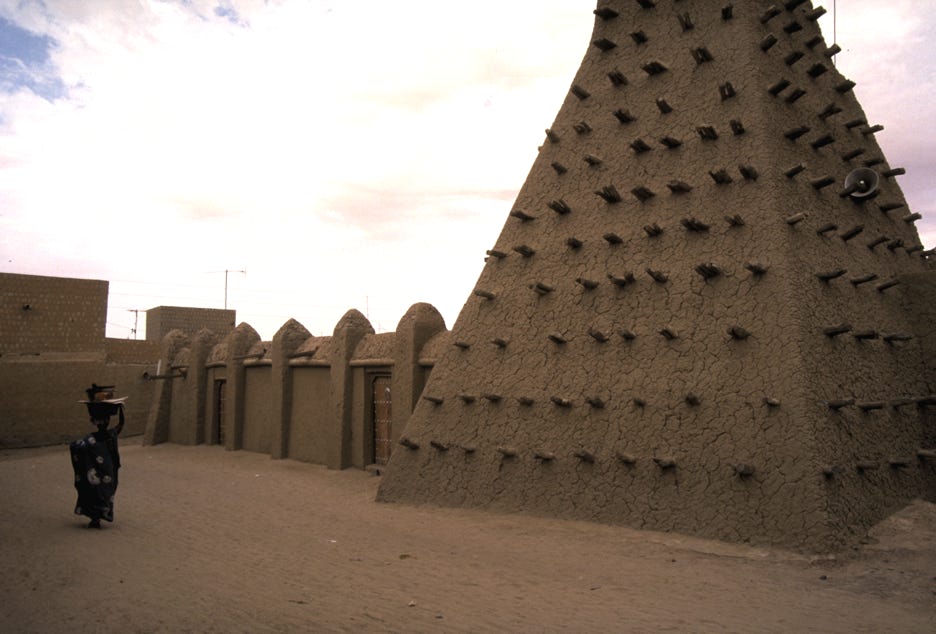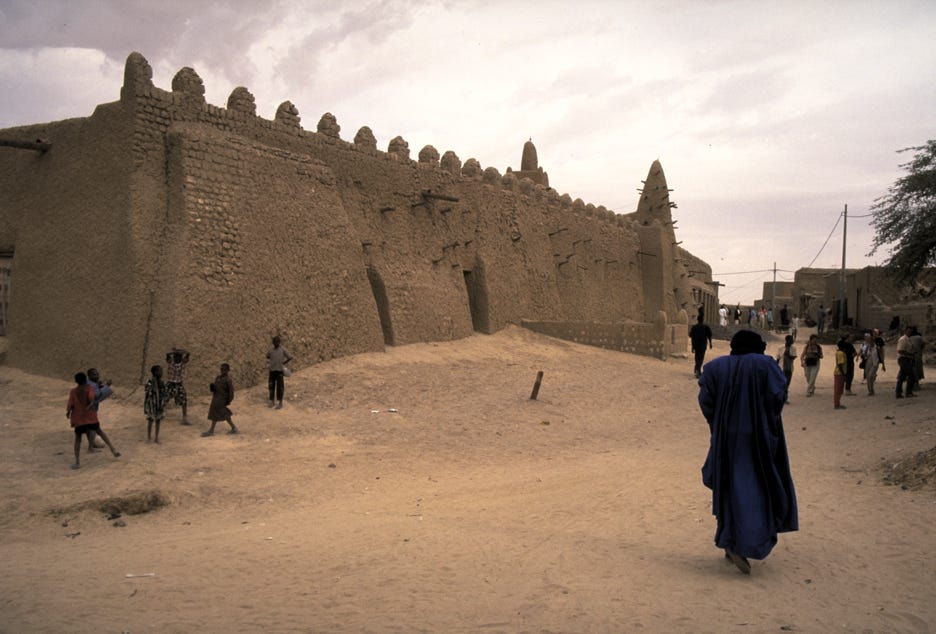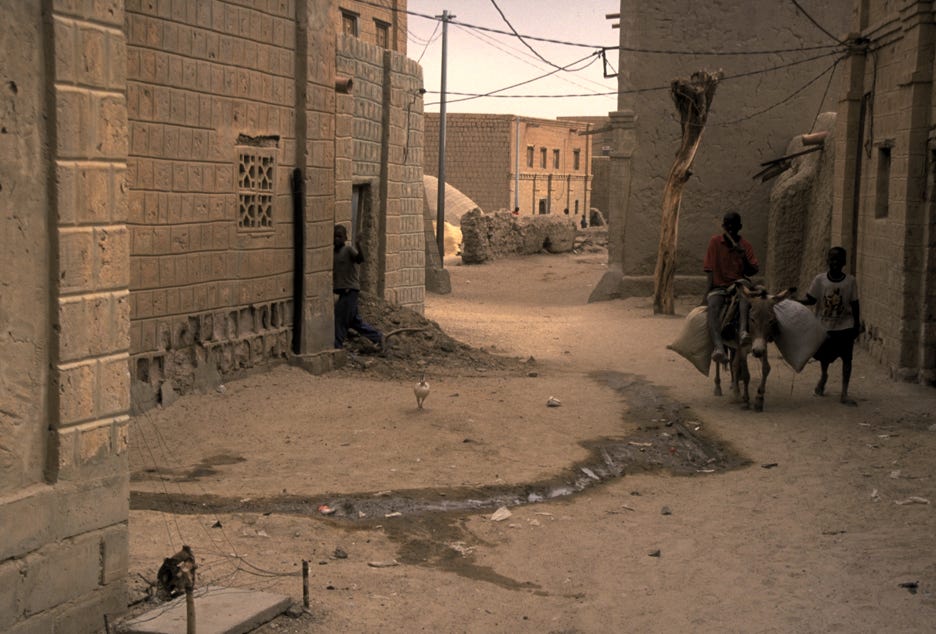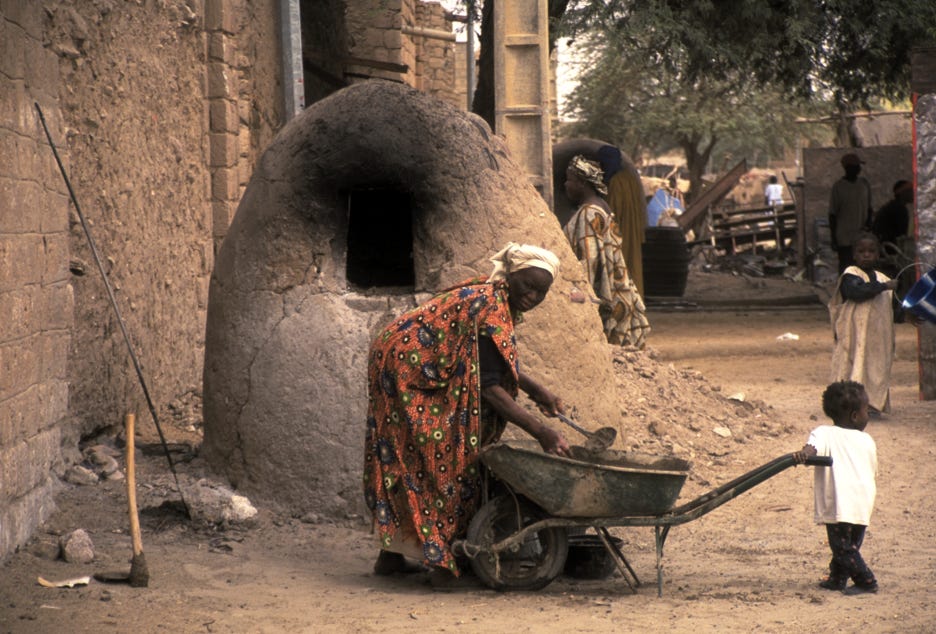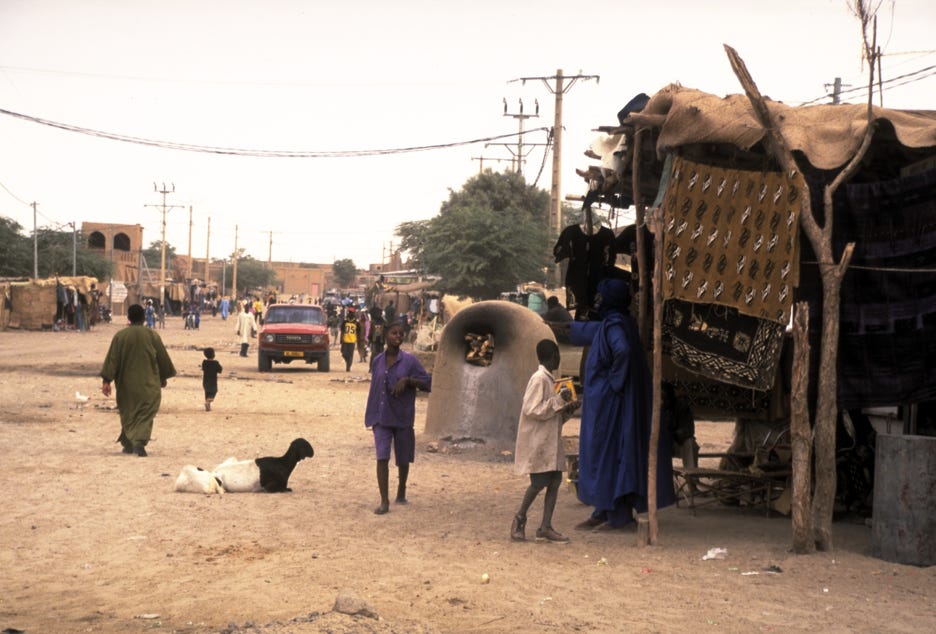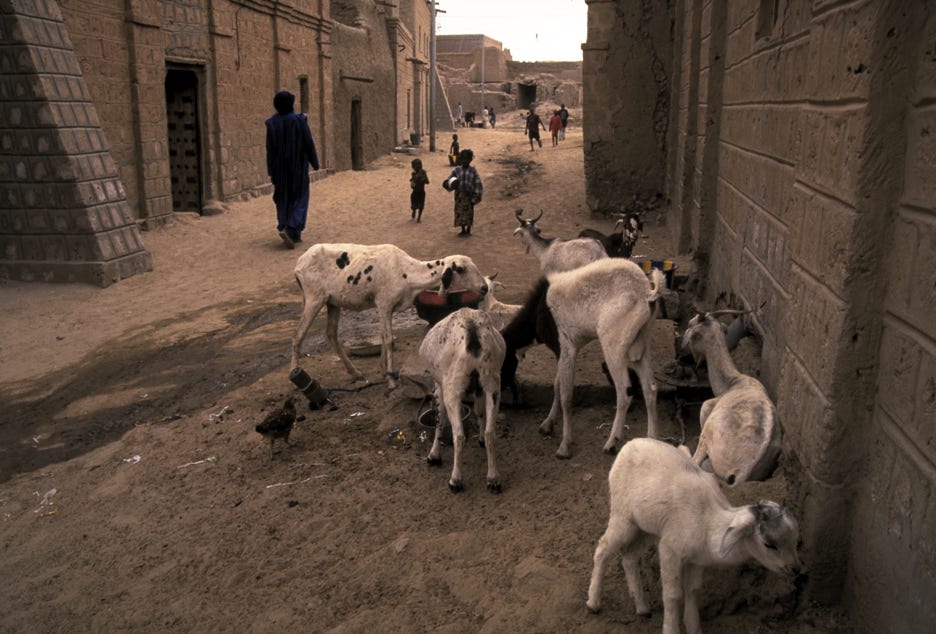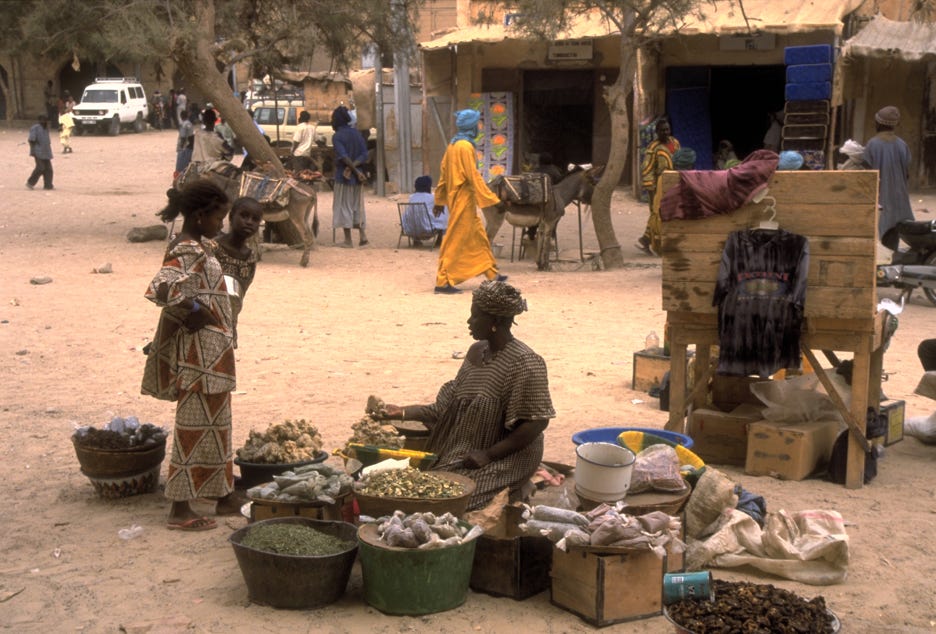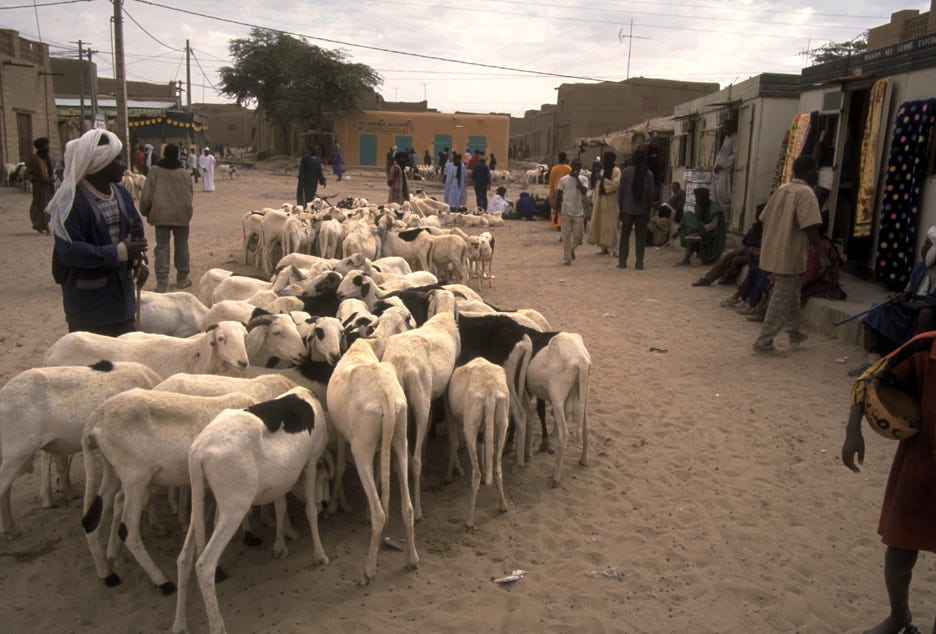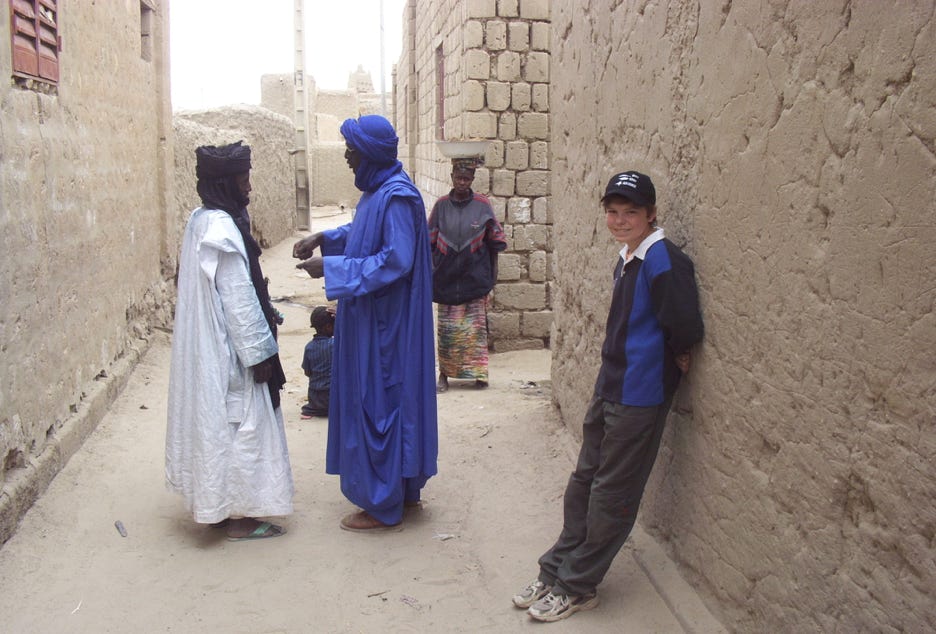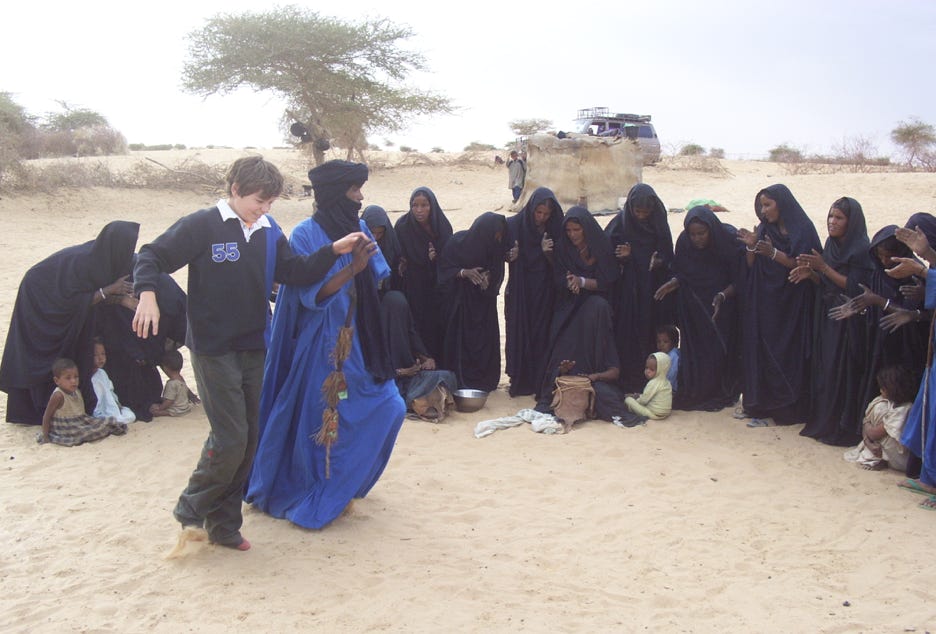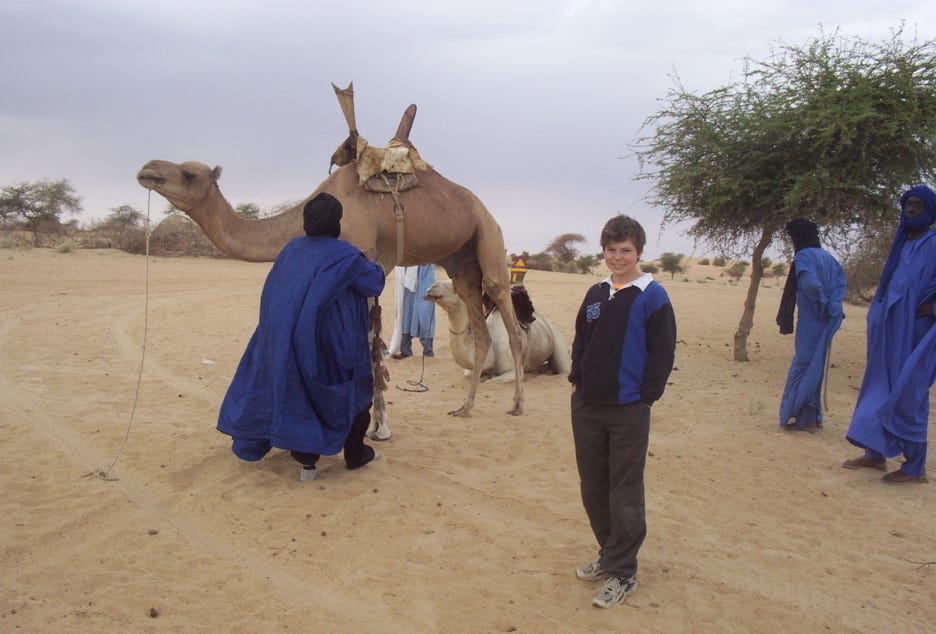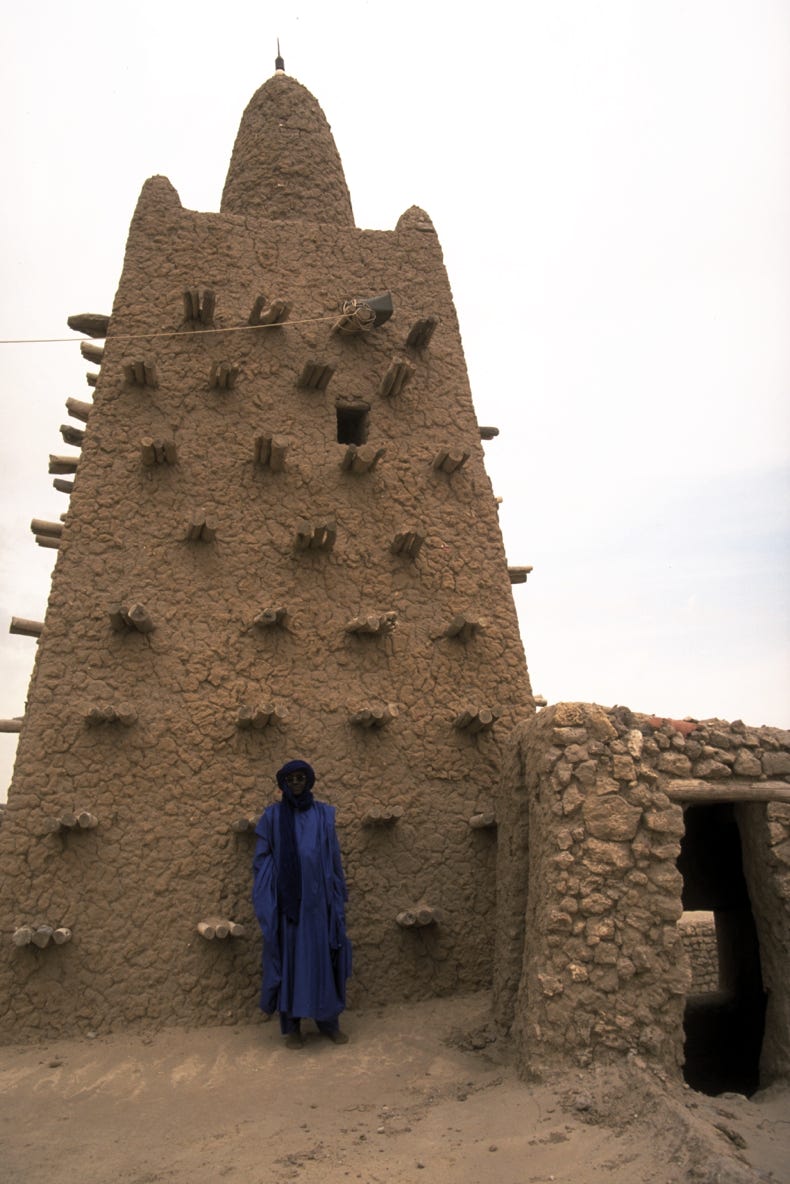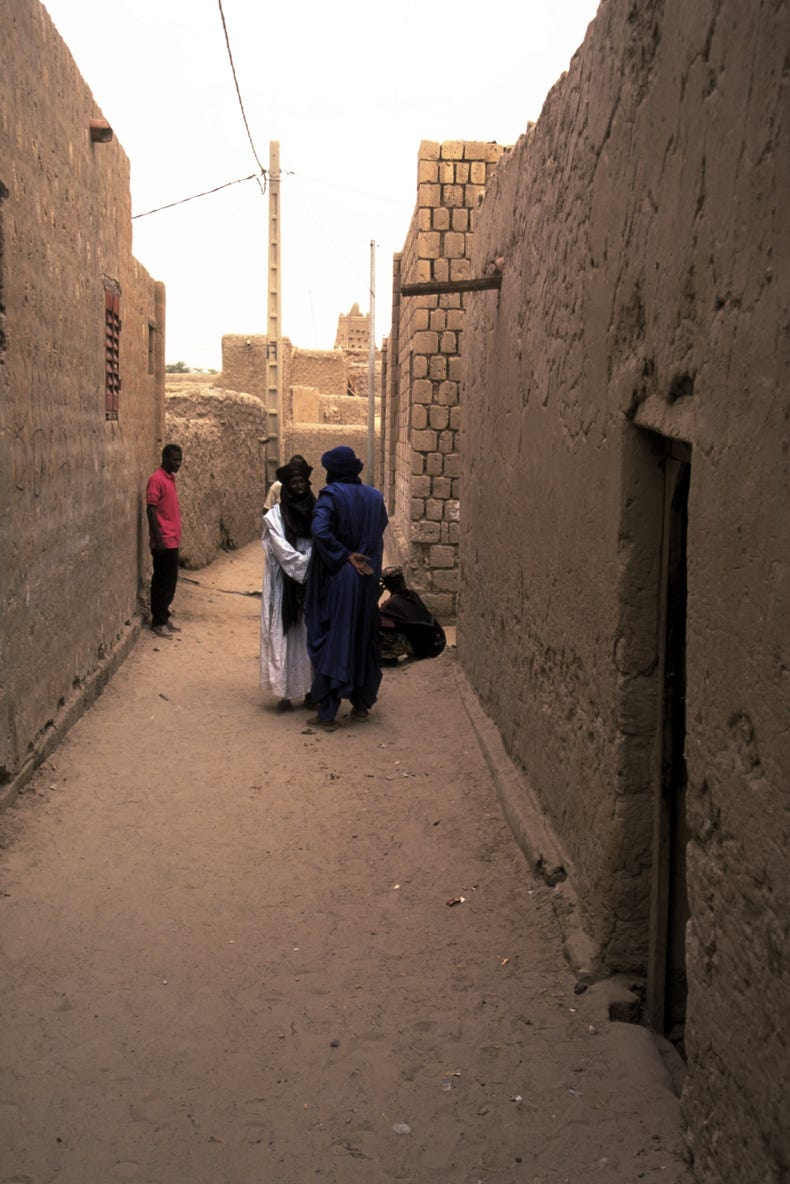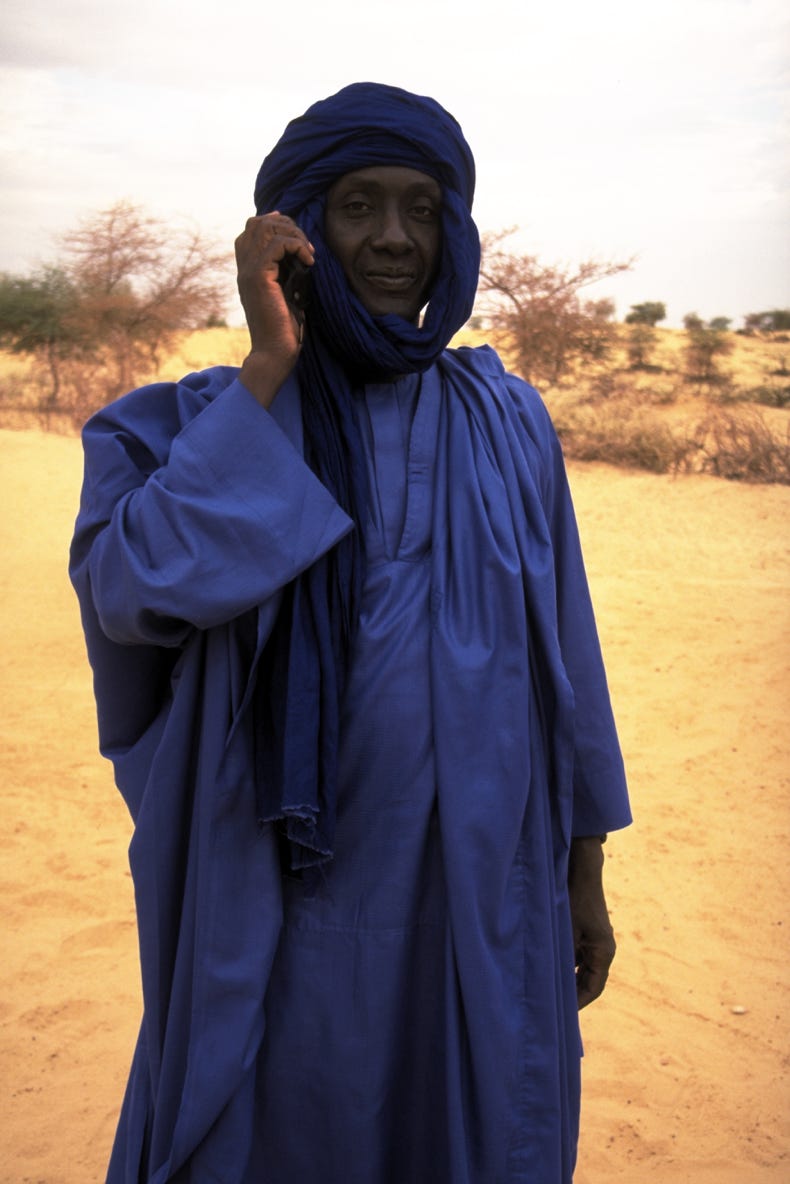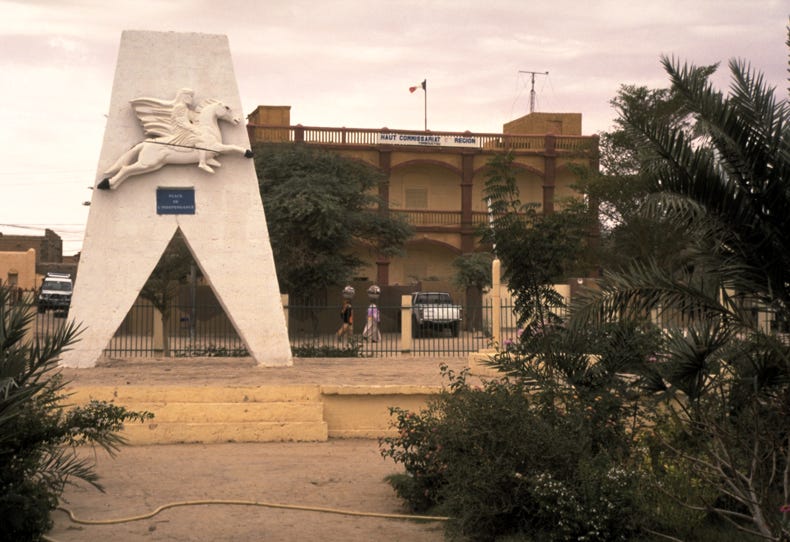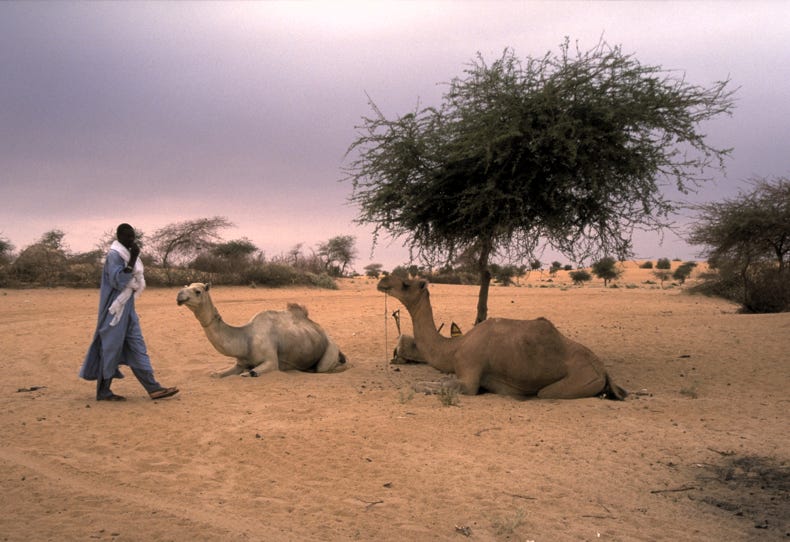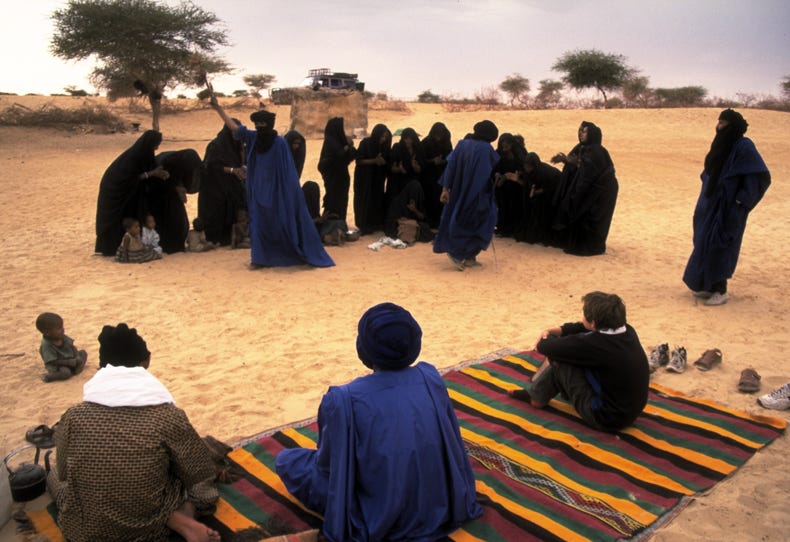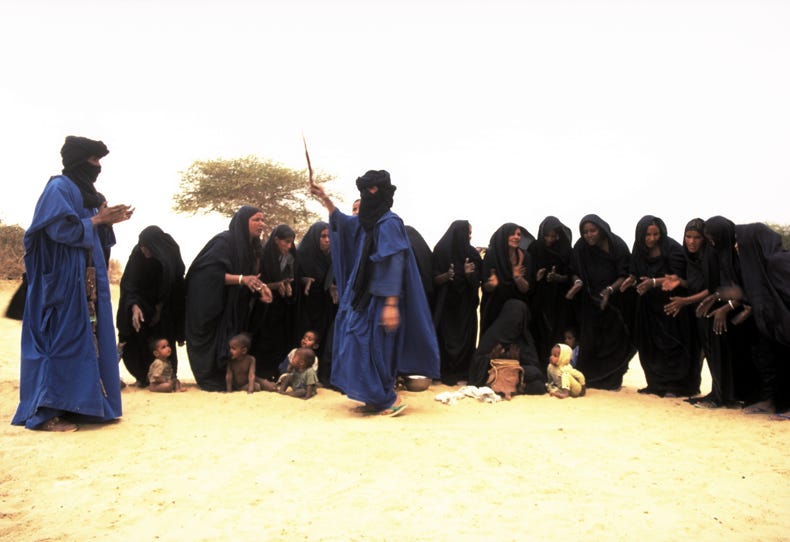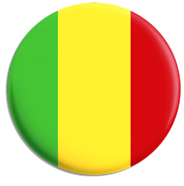

Saturday was to be our full day in Timbuktu. Just before breakfast we thought it might be under threat when the guide who had accompanied us from Bamako, Sory (an unfortunate name), told Andrew that our flight to Mopti on Sunday might be cancelled and we might have to take a full day drive back instead (the reverse of the previous day’s long bumpy drive). Apparently a soldier had been shot in Timbuktu and the government was talking of purloining the plane to fly officials in for the funeral. Anyway, in the end, everything was okay (well, for us, not for the soldier’s family I guess!), and the flight was confirmed.
So after breakfast we headed off on a walking tour through Timbuktu. Sory had to return to Mopti to meet us after our flight the next day, so we had a local guide, a man named Alice (another unfortunate name for a man – actually I think his real name was something like Halis, but he seemed to prefer Alice!). What a great experience the day in Timbuktu was!
The city, or town, is almost entirely built of mud brick, with just a few new houses built from limestone (that looks almost the same as the mud brick). The town is all single or double storeys, and with streets of sand, everything appears in monochrome colours except for the bright colours of the clothes of the people – varying colours depending on the tribe or ethnic group.
The town is slowly being buried in fine sands blowing in from the Sahara Desert, and for many of the houses you have to step down from the street into the house. The streets are populated not only with people of various tribes, but also with herds of goats and donkeys, often carrying freight. The backdrop for the town is the rolling sand dunes of the Sahara Desert, which can the seen from the roof of almost any building in the town. It is hard to think of a town that is more different from an Australian city – it is MY kind of place, as Andrew will tell you!
As with many walking tours, the real highlights are not the destinations but the everyday scenery on the way. We began at Timbuktu’s oldest mosque, built between 1325 and 1330, entirely of mud brick. Unusually for a mosque, non-Muslims are allowed to enter, and moreover, to go up onto the roof.
After the mosque, we wandered through the narrow streets of the old town, ostensibly to see houses inhabited by early European visitors to Timbuktu, some other mosques and the new indoor market. For me, the highlights were the people, the animals, the open drains running down the centre of the sandy streets, the lively ‘old’ market, the plethora of street kilns for baking bread, an open-air street koranic school (with boys all chanting the Koran that sounded just like that scene in the movie Kandahar) and the general ambience of the city that I hope the photos will convey.
Unfortunately the day was mainly overcast, and we even had a shower of rain this afternoon – probably not a typical Sahara Desert experience! The thing that was fascinating was how important greetings and relationships are to these people. People see each other and there is a warm handshake, a long conversation enquiring about the health of the person and all their relatives (individually!), followed by enquiries about the health of their animals and the state of their gardens, after which ‘normal’ animated conversation can begin. Alice (like Sory the previous afternoon) seemed to know half the population of Timbuktu, so our progress was certainly not hurried as we walked around, but this was part of the enjoyment.
We returned to the hotel for a lunch of grilled emaciated chicken with pommes frites (the same as last night’s dinner, sandy of course like all the food in Timbuktu), and we then had a couple of hours of free time before leaving for a camel trek into the Sahara starting at 3:30pm. So Andrew and I went for a walk for about an hour and a half before having a short rest.
Then at 3:30 we headed off in a 4-wheel drive vehicle out into the Sahara west of Timbuktu. After driving for almost half an hour, we came to a Tuareg encampment to meet our camels. The Tuareg are known as the ‘Blue Men of the Desert’ because they dress in very distinctive blue robes (usually with a black head scarf) dyed with indigo, and the indigo rubs off onto the skin giving it a bluish tint. Andrew had been looking forward to the camel trek as a highlight of the trip, and he was certainly not disappointed. We went for a circular trek, past a water well and some nomadic Tuareg encampments, over the dunes and back to the original encampment. There I had arranged a takamba, which is a traditional Tuareg dance.
What a magic experience – seated on a mat in the Sahara desert at dusk, in a Tuareg encampment, sipping sweet syrup-like mint tea from tiny little glasses, experiencing the rhythmic beat of the drums and seeing these fantastically dressed (in their everyday clothes!) people performing their traditional dances. In fact, visiting a Tuareg encampment is just about the only way to see a Tuareg woman, because it is usually only the men who venture into the towns. The Tuareg are unusual among Muslim groups because the women show their faces but the men almost always hide theirs (the opposite of most groups).
It was lovely to see the women standing in a semi-circle with their children seated in front of them, as the men performed the dances and one or two of the little boys joined in to practice. They invited Andrew to join in at one stage, and he made quite a good job of the dancing indeed – the whole experience was very warm and welcoming. The wonderful thing about taking Andrew on trips like this is that he is so appreciative, and this was no exception. He was certainly a happy young man as we returned to Timbuktu, stopping briefly at a well (VERY deep!) used by nomadic camel herders, where we could experience the solitude and stillness of that corner of the world’s biggest desert.
After our return to the hotel, we had only a small dinner (crepes with chocolate sauce, and of course fine sand) and Coke, before returning to our room via the small shop in the hotel. I had wanted to buy Di a Tuareg necklace, because the blue colour is beautiful, the style is usually finer than most tribal jewellery, and I thought she might like it. I had looked everywhere in Timbuktu during the day for something suitable, but hadn’t really seen anything suitable. The shop did have some thing, and with Andrew’s advice for support, I bought it for her. I also got Andy a T-shirt saying something like “I made it to Timbuktu and returned – 2004”. He really liked it, which I guess shows how much he has enjoyed his time here.
Andy (age 12) writes:
Saturday the 17th of January: Well, by today many people have come up to me saying that I’m a lady. I went to a market today where someone said to me “perfume madame?” A girl in the street came up to me late in the afternoon and said “Bonjour madame. Je m’appelle Kate.” That means Hello (formal; salut is informal.) madam. My name is Kate. (Its literal translation is Hello madam. I call myself Kate. I just thought that it was interesting.) Perhaps mum has to cut my hair soon. Anyway, We started this morning with breakfast, (I’ve said it so many times now that I have to put it in every time as otherwise you’ll think that I missed out!) before meeting up with our special Timbuktu guide which we would be spending the day with. We then headed to a mud brick mosque, which was built by a traveller who came back via Timbuktu after the pilgrimage to Mecca. We went inside it and up onto the roof. (Needless to say, dad took a heap of pictures.) Then we walked all around the town as the guide pointed out things around us such as some other mosques, places or houses owned by famous travellers and just general but interesting things around us. Dad loved this because it’s easier to take photos when you’re standing still rather than driving. Soon afterwards we walked to the market which was full of commotion and confusion; also hundreds of flies on the raw meat which was all around the market. We returned to our hotel for a quick lunch before only dad and I walked in a quick circuit around Timbuktu. After the walk, the tour guide, dad and I set off in our 4x4 for the Sahara desert. We soon arrived there and got on our camel. It was very exciting to be travelling by camel over windy sand dunes with no plants in the largest desert in the world. When we were at the top of a dune, we suddenly stopped and something brought back a memory of my time with Dad a couple of years ago in Harbin in China. There, in the middle of white dots falling gently from nowhere, dad was on a camel when it pooed. Here, it simply looked like what was a full 3-minute isolated down pour underneath dad’s camel. These camels must have huge bladders. Our destination was a 45 minute dance session performed by about 20 Tuareg dancers for a seven person, including dad and me, audience. Actually, they do this every evening for their personal entertainment (they don’t have TVs) – we were lucky to be there at the right time and join them. It was amazing at how it was so perfectly timed and at how they could make such a fantastic rhythm and music using just 2 drums and hitting them in different ways. At one stage, I was asked to get up and dance with the two dancers. It was a very enjoyable experience. We then drove to a very deep well before driving back to our hotel. After dinner, dad and I went to the hotel’s gift shop. We found a necklace which both dad and I think that mum will love. We’d been looking all round the town for a necklace for mum, as she can’t experience this. We also found a very nice shirt there. It normally costs 10000 francs but we found that in a very tiny area of the shirt, a bit of red that had rubbed of the plastic covering was on there. It will probably come off after the first wash. After the store manager saw it, he lowered the price by 2500 francs to 7500. Dad was about to say yes, I will take it but I gave him quite a hard nudge to bargain with him. Dad and I got another 1500 off so that it was down to 6000 francs, 4000 cheaper than the original price.

